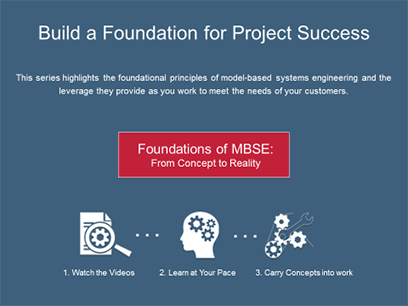“There is NO SUCH THING as non-model-based engineering”
Zane Scott, Vitech Corporation Vice President of Professional Services
An interesting quote when you consider systems engineering has spent the last ten years obsessed with the transformation to model-based systems engineering (MBSE). But Zane is exactly right. Engineering has always been, and always will be, model-based. This transformation is far less revolution and far more evolution. Nonetheless, when done well, the impact is transformational, both to the organizations that implement MBSE properly and to the systems we engineer. With an eye towards helping more practitioners and organizations understand systems engineering, MBSE, and the value it represents, Zane produced a three hour self-paced tutorial series Foundations of MBSE: From Concept to Reality. Packaged in twelve “TED Talk-length” segments and filled with thought-provoking nuggets, this series is freely available on the Vitech website.
While there are certainly advanced concepts and techniques to master, the greatest myths and misconceptions regarding MBSE reside at the foundational level – hence the focus of the series. Many misunderstandings are centered around the concepts of model-based and the evolution from low-fidelity representations in documents to higher fidelity, richer representations as we seek shared cognition across the project team. Some are grounded in misconceptions about systems engineering itself, incorrectly positioning the practice and misguiding the practitioner. Building upon such a flawed foundation leaves us vulnerable as we make the journey to an explicit, model-based profession. The biggest mistakes in a project are made on day one, and Zane seeks to correct that foundation. Likewise, Lewis Carroll said “If you don’t know where you are going, any road will get you there.” Starting from the right point of departure and understanding the ultimate destination increases the likelihood that our journey – as individual practitioners, as organizations, and as a collective community – will get us to the right MBSE destination.
If you are looking for detailed training on SysML diagrams or the features and buttonology of a specific tool, this series will not answer your questions. If you are looking to better understand systems, systems engineering, and the true nature of the transition to model-based, the self-paced tutorial is the place to start. Sessions address the challenges we face in developing systems, the underpinning concepts of systems models, a process for MBSE, the span from requirements through architecture, representations and communication in the age of MBSE, and traps to avoid on the journey to MBSE.
 Investing three hours to watch the series will not make you a competent MBSE practitioner, but it will raise your awareness of the critical concepts, positioning you to begin your journey. Whether you are new to MBSE or a seasoned practitioner, it will help you ‘begin with the end in mind’ so that you are an informed advocate and prepared to avoid decoys and detours. As with the MBSE Primer, those relatively new to systems engineering and those seeking an introduction to MBSE will find a firm conceptual foundation on which to build their practice. More seasoned practitioners will have an opportunity to realign practices and processes with the fundamental principles of systems engineering. Working from this foundation, those seeking more advanced concepts and application experience can move forward with training and mentoring to raise the systems engineering proficiency of their team.
Investing three hours to watch the series will not make you a competent MBSE practitioner, but it will raise your awareness of the critical concepts, positioning you to begin your journey. Whether you are new to MBSE or a seasoned practitioner, it will help you ‘begin with the end in mind’ so that you are an informed advocate and prepared to avoid decoys and detours. As with the MBSE Primer, those relatively new to systems engineering and those seeking an introduction to MBSE will find a firm conceptual foundation on which to build their practice. More seasoned practitioners will have an opportunity to realign practices and processes with the fundamental principles of systems engineering. Working from this foundation, those seeking more advanced concepts and application experience can move forward with training and mentoring to raise the systems engineering proficiency of their team.
As systems engineers, we must extract the model from the engineer’s mind and achieve a common understanding across the full breadth of the project team – from customer, user, and stakeholder to engineer, subject matter expert, and management. Originally, the best we could do was formal specifications – each section with a defined purpose and populated with critical information about the problem and the corresponding solution. Much as mechanical engineers evolved from hand-drawn top, left, and side projections to digital drawings and eventually integrated models in CAD, systems engineers can move from low-fidelity documents and disjoint drawings to a powerful integrated model-based approach. As with the journey from drafting to drawing to CAD, model-based systems engineering is evolutionary in approach and transformational in results. Hopefully this series will play a small role in raising awareness of the foundations across the industry so that individually and collectively we can move from MBSE concepts to MBSE reality.




